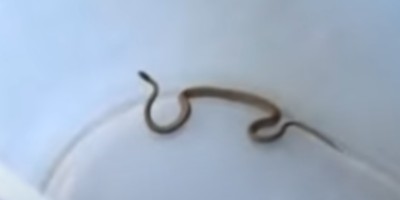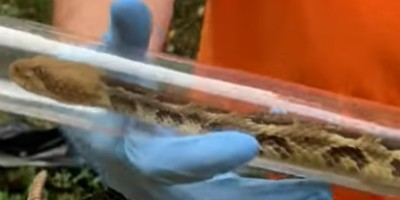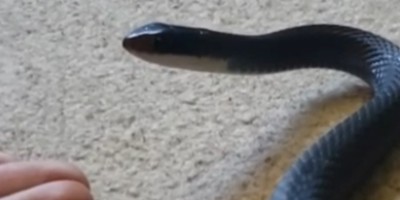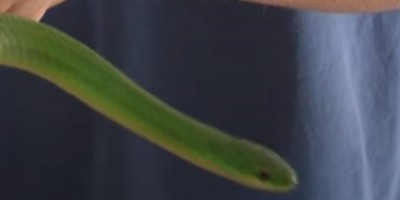
Common Snake Species in Des Moines
 Brown Snake:
Unlike other entries in this list, brown snakes (Storeria) are a family of snakes. They have a remarkable distribution, from southern Canada, down into Central America. The main brown snake (S. dekayi) is a characteristic brown with a lighter central stripe. It grows no longer than 20 inches in length. These snakes feed on slugs, snails, and earthworms. They are non-venomous and are of no threat to humans. Some subspecies can even be held. However, they are sometimes mistaken for copperheads and so are killed.
Brown Snake:
Unlike other entries in this list, brown snakes (Storeria) are a family of snakes. They have a remarkable distribution, from southern Canada, down into Central America. The main brown snake (S. dekayi) is a characteristic brown with a lighter central stripe. It grows no longer than 20 inches in length. These snakes feed on slugs, snails, and earthworms. They are non-venomous and are of no threat to humans. Some subspecies can even be held. However, they are sometimes mistaken for copperheads and so are killed.
 Eastern Garter Snake:
Eastern garter snakes (Thamnophis sirtalis sirtalis) are known for their three pale stripes: one in the mid back and two down the sides. Their bodies are slender and small, measuring around 18 to 26 inches. Being so little, they feed on earthworms, millipedes, spiders, and insects, as well as fish and amphibians. They are non-venomous but will attack if provoked. Nor is their bite harmless, as it can rarely cause an allergic reaction. You’ll find them near water, in urban lots, or slithering through suburban gardens.
Eastern Garter Snake:
Eastern garter snakes (Thamnophis sirtalis sirtalis) are known for their three pale stripes: one in the mid back and two down the sides. Their bodies are slender and small, measuring around 18 to 26 inches. Being so little, they feed on earthworms, millipedes, spiders, and insects, as well as fish and amphibians. They are non-venomous but will attack if provoked. Nor is their bite harmless, as it can rarely cause an allergic reaction. You’ll find them near water, in urban lots, or slithering through suburban gardens.
 Eastern Racer:
As their name suggests, eastern racers (Coluber constrictor) are a fast-paced predator. They are common throughout the entirety of the US, in the east and the west. They have slender bodies, measuring 20 to 60 inches. Alternately, they are known as black racers, due to their dark coloring. However, their underbelly is typically pale. They hunt rodents, frogs, toads, lizards, and other snakes. They are non-venomous and do not constrict. Instead, they kill using their strong bite to suffocate prey. Similarly, if cornered, their bite is painful, and they will fight ferociously. They’ll also release a foul-smelling musk to ward off a would-be predator. You’ll find these tenacious snakes near water, in open grassland, or up in the trees.
Eastern Racer:
As their name suggests, eastern racers (Coluber constrictor) are a fast-paced predator. They are common throughout the entirety of the US, in the east and the west. They have slender bodies, measuring 20 to 60 inches. Alternately, they are known as black racers, due to their dark coloring. However, their underbelly is typically pale. They hunt rodents, frogs, toads, lizards, and other snakes. They are non-venomous and do not constrict. Instead, they kill using their strong bite to suffocate prey. Similarly, if cornered, their bite is painful, and they will fight ferociously. They’ll also release a foul-smelling musk to ward off a would-be predator. You’ll find these tenacious snakes near water, in open grassland, or up in the trees.
 Smooth Green Snake:
Smooth green snakes (Opheodrys vernalis) are primarily found in a band stretching across the US-Canadian border and encompassing the Great Lakes. Due to their verdant color, they thrive in temperate grasslands, broadleaf forests, and wetlands. However, there are isolated pockets further south. At most, they measure 20 inches in length, although the longest smooth green snake was an impressive 26 inches. Their diet consists of insects and spiders, which they kill in the initial strike. These snakes rely on camouflage to hide from predators, and will seldom bite a human. They are also non-venomous.
Smooth Green Snake:
Smooth green snakes (Opheodrys vernalis) are primarily found in a band stretching across the US-Canadian border and encompassing the Great Lakes. Due to their verdant color, they thrive in temperate grasslands, broadleaf forests, and wetlands. However, there are isolated pockets further south. At most, they measure 20 inches in length, although the longest smooth green snake was an impressive 26 inches. Their diet consists of insects and spiders, which they kill in the initial strike. These snakes rely on camouflage to hide from predators, and will seldom bite a human. They are also non-venomous.